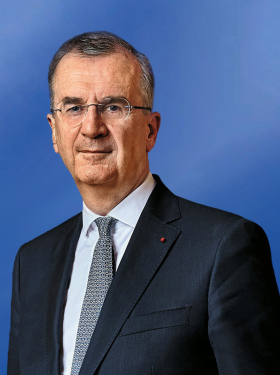- Home
- Governor's speeches
- L’Echo: "On rates, we need to proceed gr...
L’Echo: "On rates, we need to proceed gradually and pragmatically"

François Villeroy de Galhau, Governor of the Banque de France
Published on the 16th of February 2024

Interview given by François Villeroy de Galhau, Governor of the Banque de France, to L'Echo
Monetary policy is working well, reiterates François Villeroy de Galhau, Governor of the Banque de France. Inflation will indeed be back down to 2% by next year. The European Central Bank (ECB) has three degrees of freedom when it comes to future interest rate cuts: the timing of the first interest rate cut, then the pace at which rates are lowered thereafter, and the final level of interest rates. The Governor therefore urges a pragmatic and gradual approach – dictated neither by haste nor an exaggerated wait-and-see attitude.
There is a great deal of speculation concerning when exactly the ECB will start cutting its key rates. Several members of the Governing Council have alluded to next summer. Some investors and economists expect the process to begin in April or even March. What are your thoughts on this?
Lowering our rates this year now appears as granted in principle. The next question always concerns the exact time frame, but – if you'll forgive me – this is the wrong approach. The question is not "when" but "why" rates should be cut and this will be data-dependent – we are referring here to three criteria and to two risks. The three criteria refer to headline inflation, core inflation, and monetary policy transmission. Concerning the first and third, we have sufficiently solid signs of disinflation, but the trend and expectations regarding core inflation remain a more open question even though the signs are encouraging. And we have to navigate the right course between two risks: cutting rates too soon and seeing inflation start to rise again, or waiting too long and weighing excessively on activity. The second risk is now at least as important as the first.
Some analysts believe that on the way to bring inflation back to 2% target, it is the “last mile” that will be the most difficult, and that instead of easing rates too soon, the ECB should adopt a wait-and-see approach.
Our attitude should not be one of wait-and-see, but rather focusing on economic reality. I don't believe that the “last mile” is intrinsically more difficult. There is a general trend towards disinflation. It was first apparent in energy and commodity prices, but this has now extended to core inflation, which has fallen from 5.7% to 3.3% in ten months. Service inflation in particular now stands at 3.5%, not too far from its average of 2.7% during the 2000s. Disinflation may be a bit slower in these sectors, but this does not mean that the “last mile” is more uncertain or difficult.
Once the ECB has decided on the first rate cut, how quickly should monetary easing occur?
We will continue to be guided by data – and in my view there won’t be any return to forward guidance. In other words, we will have not one but three degrees of freedom: obviously, the timing of the first interest rate cut, but also the pace at which rates are lowered thereafter and ultimately, the final level to which our interest rates will fall. Having these three successive degrees of freedom may be an additional argument for not unduly delaying the first rate cut.
So you would prefer to cut rates early and then continue lowering them at a moderate pace rather than waiting and then having to cut rates more aggressively?
We should not act in a hasty manner. However, proceeding gradually and pragmatically can be preferable to deciding too late and then having to over-adjust. Like my colleagues, I have one unwavering compass : bringing inflation down to 2% and – barring any new shocks – we will achieve this commitment by next year.
Before deciding on the first interest rate cut, some ECB members would prefer to wait for wage data, which will not be available until April. Does this rule out a rate cut before June?
That is too mechanical an interpretation. As Christine Lagarde said after our meeting at the end of January, we consider the labour markets more broadly. Wage data are useful but subject to a time lag. We also need to factor in other, more forward-looking indicators.
What are these indicators?
There are at least two. The first is the degree of labour market tightness. In France, our monthly survey measures the proportion of firms facing recruitment difficulties. Since last July, over a six-month period, this has fallen from 52% to 41%. Another indicator is what is happening in terms of negotiated wage agreements. In France, we are now recording a slowdown in nominal wage increases for 2024.
Once the ECB has begun to ease rates, how low should key rates fall? In other words, what is the neutral level that rates should eventually reach?
This neutral rate is not observable in any precise manner but it is indeed a key economic variable. After declining for two decades, the neutral rate now appears to have at least stabilised. We estimate it to be around 0% in real terms, or even slightly positive. If we add in inflation at 2%, this means a neutral nominal rate of around 2% or slightly higher. But this does automatically imply that it is our target for the next rate cut cycle. It simply means that, compared with the current level of 4%, we have a significant margin for rate cuts without returning to an accommodative monetary policy.
The euro area has been flirting with recession these past few months. Do you worry that maintaining restrictive key rates for too long will end up actually triggering this recession?
Our primary objective is clear: price stability and the lasting return of inflation around our 2% target. However, once we have a good confidence that we will meet this target by 2025, we need to choose among the possible interest rate trajectories the one that will be the least costly for economic activity. So far, the ECB has managed to maintain a soft landing scenario. However, since last summer we have undoubtedly been facing a slowdown. Growth should gradually pick up over the next few years, both in the euro area and in France. We believe that disinflation will help with this.
How so?
We are in the process of returning to positive real wage growth (Editor’s note: wage increases outstripping price rises). This purchasing power will support consumption, especially as the saving rate has barely receded so far. It will also be conducive to a gradual recovery in the sensitive housing sector, in conjunction with the stabilisation of interest rates and a certain decline in housing prices. Domestic demand should therefore bolster growth. Moreover, as disinflation brings interest rates down, this will be another positive factor for household consumption and business investment. Barring any shock, our baseline scenario is therefore a slowdown followed by a recovery rather than a recession. So we are a long way from the gloomy scenario of stagflation that was so feared in late 2022. This is the sign that monetary policy is working well.
Some analysts dispute that monetary policy was the real cause of disinflation, given that the fall in energy prices played a decisive role.
There is no doubt that disinflation was helped by a reversal of the shock in energy and commodity prices, which had fuelled the inflationary surge in the wake of the Russian invasion of Ukraine. But there has also been a decline in core inflation, which would have remained higher and been more persistent if we had not reacted in an appropriate manner. On both sides of the Atlantic, monetary policy has been much more effective than during the previous inflationary shock of the 1970s, due to two main differences. First, central banks, including the ECB, acted rapidly, and the effects of this intervention were quickly transmitted to the economy via bank lending. Second, the inflation expectations of economic agents – both households and businesses – have risen slightly, albeit without being “deanchored”, which proves the credibility of central banks. This enhanced credibility is underpinned by their independence and the clarity of their 2% inflation target. This "expectations channel" means that it is probably not necessary to raise interest rates as high as before.
Aside from all that, I cannot completely resist the temptation to paraphrase the famous response of the French General Joffre, whose role in the victory at the Marne in September 1914 had been called into question. He humorously quipped: "I don't know who won the Battle of the Marne, but if it had been lost, I know who would have lost it.” Well, if the battle against inflation had been a failure, central banks would certainly have been held responsible...
Updated on the 22nd of February 2024